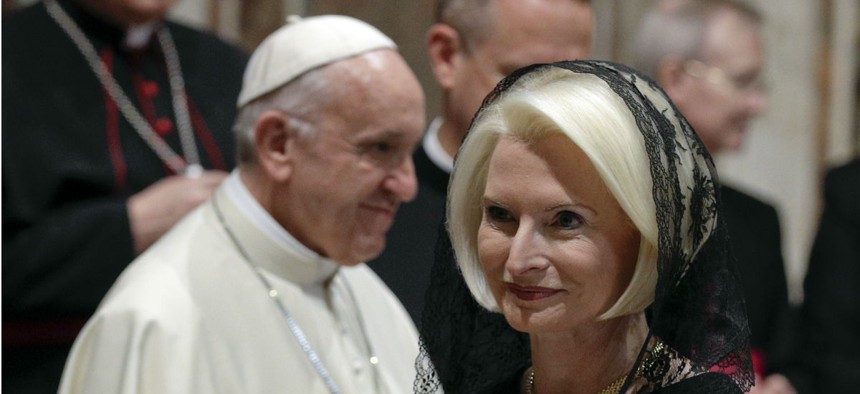
U.S. Ambassador to the Holy See Callista Gingrich walks past Pope Francis during an audience on Jan. 8. Trump is behind Obama in filling overseas posts. Andrew Medichini/AP
Trump’s Pace of Naming Ambassadors Trails That of Predecessors
There are 41 vacancies, including many in trouble spots where diplomacy is critical.
The high vacancy rate at top positions controlled by the Trump administration extends to the ambassadorial slots, though the White House and State Department can point to some recent progress.
On Wednesday, the Senate voted 50-49—including a tie-breaking aye vote from Vice President Mike Pence—to confirm Kansas Republican Gov. Sam Brownback to be ambassador for international religious freedom.
But according to a tracker kept by the American Foreign Service Association, the union for current and retired diplomats, Trump “trails the Obama Administration by 37 percent on senior official nominations, 31 percent on ambassador nominations, and over 33 percent overall on State/USAID nominations,” a spokesman said.
As of Jan. 19, Trump had named 64 ambassadors and 24 official nominations for assistant/under/deputy secretaries, for a total of 88 nominations between the State Department and the U.S. Agency for International Development.
That compares unfavorably with the Obama team during its first year, in which it named 93 ambassadors and 38 official nominations, for a total at State and USAID of 131.
A count from the AFSA tracker as of Jan. 24 shows 41 vacancies at overseas envoy slots, including those to such key or troubled countries as South Korea, Australia, Saudi Arabia, Egypt, Turkey, Ireland, Venezuela and the European Union, as well as slots below the ambassador level at the United Nations.
Some of the delays are caused by the Senate—18 of Trump’s nominations have yet to be confirmed.







